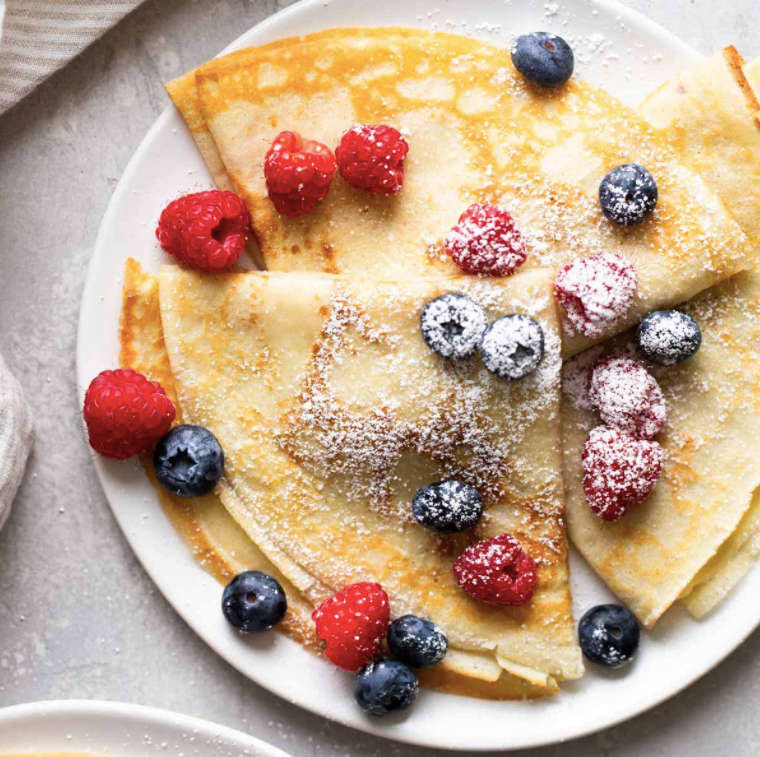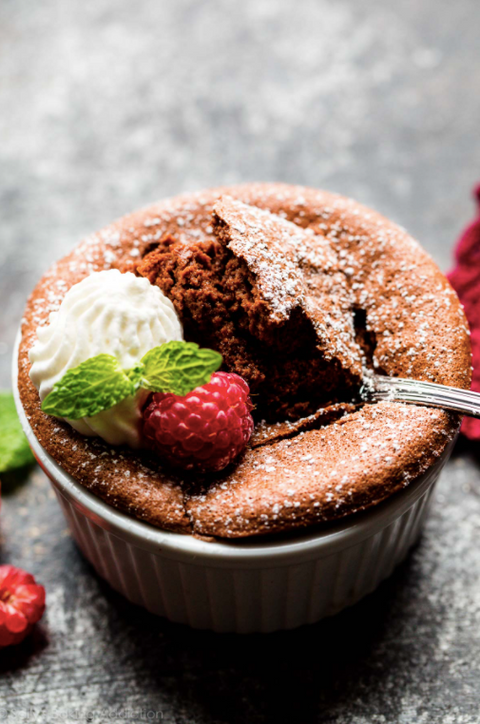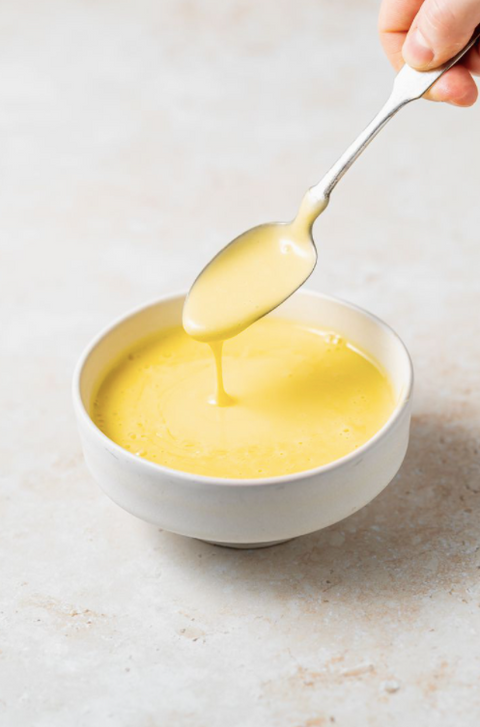Crepes
Crepe is a French word that means pancake. It is pronounced "crap" (rhyming with sap) and is derived from the Latin crispa, meaning "curled." Therefore, it could be thought of as a thin pancake — or a thick blintz — and can be eaten for breakfast, lunch, or dinner.
A crepe is made from a thin batter cooked on one side until it puffs slightly and turns golden brown. The result is a lacy, almost transparent pancake that can be round, square, or rectangular, depending on the pan used to make them.
Crepes are French Food
Crepes originated in Brittany, a region in France. They were made at the end of a meal using the leftover ingredients from other dishes, like flour and eggs, to create a thin cake. These are called galettes and are still popular in France today.
You'll find crepes all over France in cafés and Crêperies where they're cooked on large griddles known as billigs — typically made of cast iron or aluminum — that are heated by gas flames. The batter is spread over them with a special wooden utensil called a Rozell and cooked until golden brown on one side before being flipped to cook the other side.
Difference between Crepe and Pancake
Have you ever wondered what the difference is between crepes and pancakes? Unfortunately, the two are often confused because they're flat, round, and delicious.
However, some key differences set them apart. Let's look at both and see how they compare.
Pancakes
- The pancake originated in ancient Greece. It was originally made out of a soft cheese curd batter that was fried or grilled.
- It's a quick-cooking breakfast food made from a batter of flour, eggs, milk, sugar or salt and melted fat like butter or oil. A liquid batter is poured onto a griddle or pan heated to high temperatures and cooked on one side until bubbles form on the uncooked side, then flipped over to cook on the other side.
- Pancakes are generally thicker than crepes, with baking powder causing pancakes to rise quickly when cooked. The edges can be uneven and crisp, but the center is usually light and fluffy. Pancakes are traditionally served with butter and syrup or fruit toppings. They're often eaten as a standalone dish rather than as another meal.
Crepes
- Crepe pans are usually cast iron and have low, gently sloping sides. There are no ridges in the pan, so the crepes will not have ridges after cooking. Crepes can also be made in heavy skillets with sloping sides; omelet pans are called omelets.
- Crepes are very versatile because they can be sweet or savory and are easy to prepare. They can be filled with fruit, chocolate, cheese, meat, seafood, or vegetables. Crepes may also be filled with pudding or custard for desserts or folded around omelet fillings.
Sometimes Crepes become Rubbery
The most likely reason you're having trouble with crepes is that your batter is too thick. Crepe batter needs to be thin enough that you can pour it, and if it's too thick, it will be a little rubbery when cooked. Instead, add more milk or water to your batter, and mix until the consistency is very smooth. If you add too much liquid by accident, try adding flour one tablespoon at a time until the batter reaches the right consistency.
Another way to get your crepes just right is to make sure that your pan is hot enough before pouring in the batter. Place a small amount of butter into your pan, heat it on medium-high heat for about 30 seconds, and then pour in a quarter cup of batter. Swirl the pan around so that all of the butter has been absorbed by the Crepe, and cook for about two minutes on each side.
Taste of Crepe
Crepe is a very thin pancake. It is mostly used in French cuisine as a dessert. Crepe has a sweet but delicate flavor. Because of its thinness, it is light and crisp but still soft and moist at the same time.
Crepe is also versatile when it comes to flavorings. It can be served with sweet and savory fillings, like chocolate sauce, fruits, or meaty toppings. You can get expert in serving Crepes with the help of Sallybakingaddiction website.
Eating a Crepe
There are many, many ways to eat a crepe.
The most traditional, and probably the most common, is to eat it with a fork and knife. For example, this is what you do in a restaurant.
However, you can also eat it with your hands in certain situations. If the Crepe is filled with something that doesn't make too much mess then in this case, you might fold the Crepe in half before eating it.

If you're eating a sweet crepe and want to live dangerously, you can also use your fingers; it's not unheard of to take a bite from one end of the folded Crepe and close it up again around the filling without using utensils.
Tips to flip the Crepes
So, here are my tips for getting the flipping process right:
- Use a non-stick pan or well-seasoned cast-iron skillet. This will help prevent tearing and sticking.
- Cook your Crepe low and slow over medium-low heat. The lower heat cooks the Crepe more gently and evenly and gives it a chance to cook through without browning too much on the bottom (which can make it stick to the pan).
- Add just enough batter to coat the bottom of the pan thinly in an even layer. If there are any gaps in the batter, fill them in with a little extra batter before cooking so that you don't end up with holes in your crepes once they're cooked.
- Use a rubber spatula to loosen the edges of the Crepe while they cook so that they don't stick to the pan.
How do the French eat crepes?
The French eat crepes, or "pancakes," for breakfast and dessert. Thin, tender crepes are served with various toppings such as Nutella, bananas, chocolate, lemon, and sugar.
Crepes are also used to make sweet and savory dishes such as galettes de sarrasin (buckwheat pancakes with cheese and ham), ratatouille (Crepe stuffed with stewed vegetables), and crêpes Suzette (crepes served in a warm caramel sauce).
Serving a Crepe
You probably think of delicious breakfast or brunch food when you think of crepes. But did you know that crepes are served as both hot and cold treats?
Hot crepes are made from a very similar batter to pancake batter, except it contains less liquid. Cold crepes are made from a batter that includes more liquid and is more like dough. Why the difference? The answer lies in lecermedelacrumb website the way they're traditionally served.
Hot Crepes
Hot crepes are made from a thin, unleavened batter (no yeast or baking powder). The batter is mixed with flour, eggs, milk, and butter (and sometimes additional flavorings such as vanilla extract or lemon zest), poured onto a hot griddle or skillet, and cooked for just a minute on each side until lightly browned.
- The filling is added to the center of the Crepe after it's been cooked, and then the sides of the Crepe are folded in to keep it all together.
- Sweet fillings such as jam or Nutella can be used, but savory fillings are also common. Some examples include sausage and cheese, spinach with ham, chicken with mushrooms and onions, salmon with cream cheese and capers, etc. The sky's the
Crepes are Healthy option
Crepes are a popular European-style dish made from thin, lightly cooked batter. They can be eaten as a breakfast food, dessert, or even as a main course.
Crepes are a relatively healthy food choice. The batter contains only nutritious ingredients like flour, eggs, and milk. And while crepes are traditionally cooked in butter, they don't have to be. Butter can easily be replaced with other cooking oils like olive oil or coconut oil, containing more healthy fats.
- However, the type of Crepe you eat can make all the difference in nutritional value. For example, savory crepes normally include nutrient-dense ingredients like meat, cheese, and vegetables, while sweet crepes may contain added sugar (and perhaps other unhealthy ingredients) to enhance their flavor.
- Depending on how it's prepared and what you choose to fill it with, a crepe can be a healthy choice that fits into almost any diet plan.
Reason of Crepes for being so good
Crepes are delicious and versatile, and they can be eaten at any time of the day.
- Crepes are thin pancakes made from a batter consisting of eggs, flour, and milk, with various fillings that can vary from sweet to savory.
- The French have made them famous around the world, but they come in many different shapes and sizes depending on the country, so you're likely to find something to suit your palate.
Popularity of Crepes in France
Crêpes are a very popular food in France. They are made with batter, made with flour, eggs, and milk. The batter is poured onto a hot surface and then spread thin and flat. When the crêpe is ready, it is flipped over and cooked on the other side.
Crêpes can be served with various fillings, both sweet and savory. For example, they can have chocolate or jam inside or be filled with vegetables or meat. Crêpes are often eaten for breakfast in France, but they are enjoyed every day! Also you can enjoy crepes while adopting the way of allrecipes website.
Food which goes with Crepes
Crepes go well with a variety of foods. You can put almost anything on them, but the best crepe fillings are sweet and delicious. I've included a list of some of the most popular crepe fillings below:
- Fruit - berries and bananas are popular choices, but you can use almost any fruit. Slices of apple or pear can be topped with cinnamon, or you can mix diced fruits with whipped cream for a delicious treat.
- Jam - strawberry jam goes particularly well with crepes, but the choice is yours. Pick your favorite!
- Custard - many people like to mix custard powder in with their beaten eggs to make thicker crepes that hold together better. This is fine if you want to make thicker crepes, but it's unnecessary. Custard is also popular as a filling.
- Chocolate - chocolate chips or grated chocolate goes very well in sweet crepes. You can also add cocoa powder to your batter to make chocolate crepes.
- Nutella - this hazelnut spread is incredibly tasty and goes well with sliced strawberries and bananas in sweet crepes.
Do the French eat crepes for breakfast?
The French eat crepes for breakfast, but not as often as for other meals. They also eat whole-grain cereal with yogurt and fruit for breakfast. A typical French breakfast does not include eggs, waffles, pancakes, bacon, or sausage. Instead of these items, the most common breakfast foods are:
- Brioche (a buttered bread that is somewhat sweet) with jam or honey
- Cereal such as corn flakes or muesli with milk
- Fresh fruits
- Yogurts
- Coffee with milk
However, the French do eat croissants for breakfast!
Drinks with Crepes
While crepes are a traditional part of the French diet and culture, crepes have become one of the most popular snack foods worldwide. In France, they are eaten as a snack or meal. Crepes are usually served with wine and coffee or tea.
If you want to stick with the French theme, try pairing your crepes with a nice chardonnay, pinot grigio, Riesling, or sauvignon Blanc.
- And if you prefer red wine, go for a pinot noir or cabernet sauvignon.
In general, white wines pair better with dessert crepes (the sweet ones), while red wines pair better with savory crepes (the ones filled with vegetables and meat).
Crepes Fillings
- Crepes Fillings for Desserts
- Vanilla Cream Cheese and Strawberry Jam
- Strawberries, whipped cream, and a drizzle of honey
- Blueberries, a dollop of Nutella, and a dusting of powdered sugar
- Nutella and banana slices
- Lemon curd and fresh raspberries
- Pumpkin butter, toasted pecans, sliced bananas, and powdered sugar
- Cinnamon and sugar with a pat of butter
- Chocolate hazelnut spread with chopped toasted hazelnuts.




